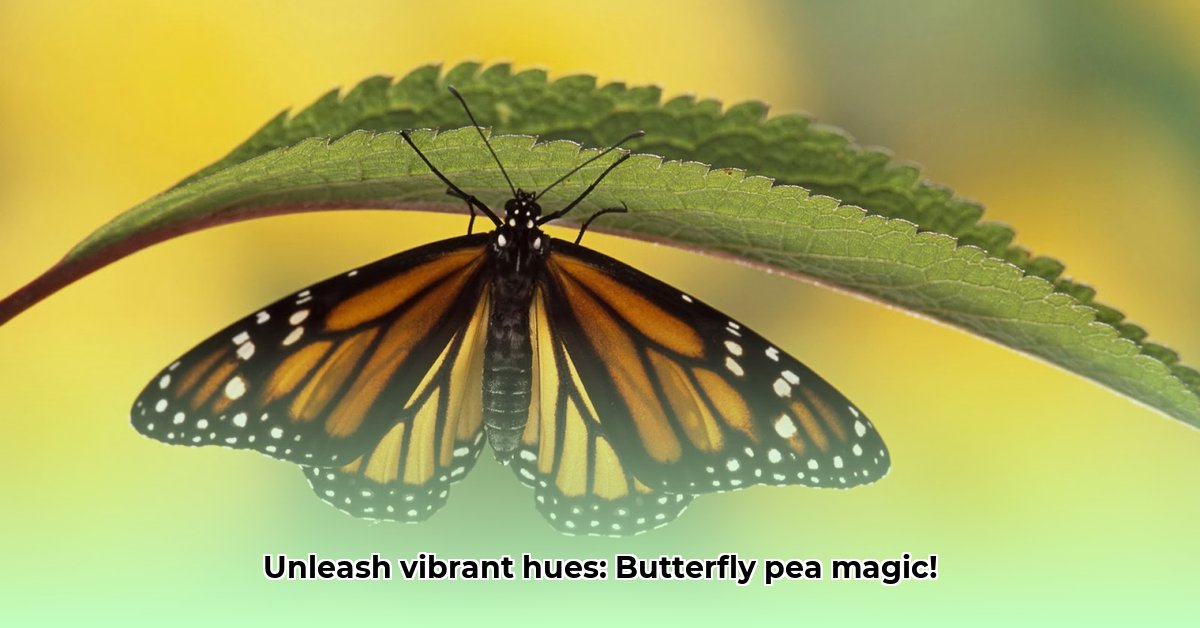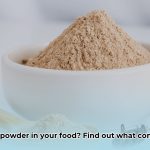Ever been mesmerized by a drink that seems to magically change color? That’s the captivating allure of butterfly pea flower powder! This remarkable powder, derived from the vibrant blue butterfly pea flower, isn’t just a visual delight; it’s brimming with potential health benefits and offers a unique twist to your favorite recipes. Let’s embark on a journey to explore this fascinating ingredient, from its origins and botanical makeup to effortless recipes for teas, cocktails, and even cakes. Discover the science underpinning its color-changing properties and learn how to source it ethically. Prepare to infuse your culinary creations with a burst of vibrant color and flavor, while exploring its potential health-promoting properties!
Unveiling Butterfly Pea Flower Powder: The Culinary Chameleon
Butterfly pea flower powder – have you heard about this vibrant, culinary chameleon? It’s a fantastic ingredient that adds a wow-factor to your cooking and drinks, thanks to its incredible color-changing abilities. Let’s dive in and uncover the magic behind this fascinating powder, and learn how it can transform your culinary creations into mesmerizing works of art, offering an exciting avenue to elevate both the visual appeal and potential health benefits of your dishes.
Decoding Butterfly Pea Flower Powder: A Botanical Overview
This amazing powder comes from the Clitoria ternatea plant, a tropical vine native to Southeast Asia, known for its intensely blue flowers. The plant thrives in warm, humid climates and has been used for centuries in traditional medicine and culinary practices. Imagine a sprawling vine bursting with these gorgeous blooms! The brilliant blue color comes from anthocyanins, natural compounds that are also powerful antioxidants. The powder itself is a deep, rich indigo, almost like a midnight sky. But here’s the best part: the color transforms! Add a bit of lemon juice or another acid, and watch it magically shift through purples, violets, and finally, a soft pink. It’s like having your own personal, edible mood ring! This natural color-changing property makes it a unique and exciting ingredient for culinary exploration. The anthocyanins are sensitive to pH levels, which explains the dramatic color shifts when acids or bases are added.
Navigating the Health Buzz: Benefits and Cautions
Let’s talk about the health benefits, but with a dose of realism. Many people are excited about the potential antioxidant properties of butterfly pea flower powder—anthocyanins are important for protecting our cells from damage caused by free radicals. Some studies also suggest it might have positive effects on blood sugar levels, skin health, and even brain function, potentially improving memory and focus. For example, research indicates that the antioxidants found in butterfly pea flower may help protect against cell damage and complications related to diabetes. However, it’s crucial to understand that research is still ongoing. These are promising early findings, not definitive proof. More research is absolutely needed before we can make strong claims.
It’s also important to note that while generally safe, allergic reactions are possible. As with any new ingredient, start with small amounts to see how your body responds. Always consult your doctor or a healthcare professional before using butterfly pea flower powder as a supplement, especially if you’re taking other medications—there’s a lack of complete research on potential drug interactions. Experts recommend that pregnant or breastfeeding women exercise caution and consult their healthcare provider before consumption. Some individuals have reported mild side effects like nausea or stomach upset, but these are rare.
Culinary Creations: Recipes and Techniques
Ready to get creative? Butterfly pea flower powder is incredibly versatile in the kitchen. Let’s explore some exciting ways to use it:
1. The Magical Butterfly Pea Tea:
This is the easiest way to start. Simply steep about a teaspoon of butterfly pea flower powder in a cup of hot water (around 175°F or 80°C) for 5-7 minutes. You’ll get a gorgeous deep blue tea. The real magic happens when you add a squeeze of lemon or lime—watch it transform into a beautiful purple hue! Experiment with different amounts of citrus to find your perfect shade. You can also add honey or other sweeteners to taste. For a refreshing iced tea, chill the brewed tea and serve over ice with a slice of lemon or lime.
2. Color-Changing Cocktails:
Elevate your cocktail game! Add butterfly pea flower powder to your favorite spirit—gin, vodka, rum, even tequila—and watch the color change as you mix in your favorite juice or mixer. Lime juice creates a vibrant violet, lemonade gives a lovely lavender, and other acidic mixers will produce slightly different shades. It’s cocktail alchemy! For a visually stunning effect, try layering the ingredients. For example, pour the blue-infused spirit over ice, then slowly add the acidic mixer to create a gradient effect.
3. Enchanting Cakes and Cupcakes:
Bake with a twist! This powder lends a subtle floral flavor and a breathtaking color to your baked goods. It complements vanilla, lemon, and coconut beautifully. Be aware that the color might be more subdued in baked goods than in drinks, but it still adds that special something. For a more intense color, you can bloom the powder in a small amount of hot water before adding it to your batter. Start with a small amount of powder and gradually increase it until you achieve the desired hue.
4. Vibrant Rice Dishes:
Add a touch of vibrant blue to your rice dishes! Incorporate the powder while cooking your rice, especially if you’re using coconut milk or a creamy sauce. The result is a stunning, visually captivating side dish. You can also use butterfly pea flower tea as the liquid for cooking rice for an even more intense color. For a fun twist, create a layered rice dish with different colors by cooking portions of rice with varying amounts of butterfly pea flower powder and acidic ingredients.
5. Mastering the pH Scale (for the adventurous):
The color-changing magic is all about pH levels—how acidic or alkaline something is. Experiment with different levels of acidity by adding things like lemon juice, vinegar, or even baking soda (which is alkaline). You can create mesmerizing gradients of blue, purple, and pink in layered desserts or drinks. Have fun exploring the color spectrum!
Ethical Sourcing and Sustainability
As with any ingredient, it’s crucial to consider where your butterfly pea flower powder comes from. Look for companies that prioritize ethical sourcing and sustainable practices. Fair trade certifications are a great indicator that the farmers are being treated fairly and the environment is being protected. Supporting responsible businesses ensures the long-term health of both the butterfly pea plant and the people who grow it. Look for brands that are transparent about their sourcing practices and support local communities in Southeast Asia.
Frequently Asked Questions (and a few considerations):
- Is it safe? For most people, yes. However, like any ingredient, allergic reactions are possible, so introduce it slowly and watch for any adverse effects. People with known allergies to plants in the Fabaceae family (which includes beans and peas) should exercise extra caution.
- Are there any drug interactions? While generally considered safe, there isn’t extensive research on potential drug interactions. It’s always best to talk to your doctor if you’re on medication before adding it to your diet. Certain medications, such as anticoagulants and antiplatelet drugs, may interact with the compounds in butterfly pea flower, potentially increasing the risk of bleeding.
- How should I store it? Keep your butterfly pea flower powder in an airtight container in a cool, dark, and dry place. This helps maintain its vibrant color and freshness and prevent it from clumping. Exposure to light, heat, and moisture can degrade the powder and reduce its potency.
- What does it taste like? Butterfly pea flower powder has a mild, slightly earthy, and subtly floral flavor. It’s not overpowering, so it blends well with other ingredients. Some people describe it as having a taste similar to green tea.
Weighing the Pros and Cons:
| Pros | Cons |
|---|---|
| Stunning natural color-changing properties | Limited robust human studies on long-term health effects |
| Potential antioxidant and health benefits | Potential for allergic reactions in sensitive individuals |
| Versatile culinary and cocktail applications | Flavor is subtle and may need to be balanced with other ingredients |
| Ethically sourced options readily available | May interact with certain medications; consult a healthcare professional |
| Adds a unique and visually appealing element to dishes and drinks | Color can be affected by the pH of other ingredients |
Butterfly pea flower powder offers an exciting array of culinary possibilities and potential health upsides. However, responsible consumption and ethically sourced products are key. Happy experimenting!
Crafting Captivating Cocktails: How to Use Butterfly Pea Flower
Key Takeaways:
- Butterfly pea flower’s vibrant blue color dramatically shifts with pH changes, creating stunning visual effects in cocktails.
- Its mild, slightly earthy flavor complements various spirits and mixers.
- Mastering the technique involves understanding the balance between butterfly pea flower concentration and the acidity of your chosen ingredients.
- Ethical sourcing and sustainability are important considerations when choosing your butterfly pea flower powder.
What is Butterfly Pea Flower Powder?
Butterfly pea flower (Clitoria ternatea) hails from Southeast Asia. Its vivid blue color comes from anthocyanins, potent antioxidants. These compounds react to acidity, changing the flower’s hue. Imagine a magical chameleon, adapting its color to its environment! That’s the essence of this ingredient’s appeal. The powder itself is delicate, almost earthy in flavor. The flowers are traditionally used in Ayurvedic and traditional Chinese medicine for their potential health
- Fun Facts About Hydropower And How Water Makes Electricity - January 6, 2026
- Hydro Power Everyday Keeps Lights On and Water Flowing - January 5, 2026
- What Are Some Fun Facts About Hydroelectric Energy? - January 4, 2026
















